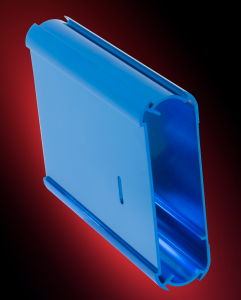Powder coating is by far the youngest of the surface finishing techniques in common use today.
Powder coating is the technique of applying dry paint to a part. The final cured coating is the same as a 2-pack wet paint. In normal wet painting such as house paints, the solids are in suspension in a liquid carrier, which must evaporate before the solid paint coating is produced.
In powder coating, the powdered paint may be applied by either of two techniques.
- The item is lowered into a fluidised bed of the powder, which may or may not be electrostatically charged, or
- The powdered paint is electrostatically charged and sprayed onto the part.

The part is then placed in an oven and the powder particles melt and coalesce to form a continuous film.
There are two main types of powder available to the surface finisher:
- Thermoplastic powders that will re-melt when heated, and
- Thermosetting powders that will not re-melt upon reheating. During the curing process (in the oven) a chemical cross-linking reaction is triggered at the curing temperature and it is this chemical reaction, which gives the powder coating many of its desirable properties.
Preparation
The basis of any good coating is preparation of the aluminium. The vast majority of powder coating failures can be traced to a lack of a suitable preparation.
The preparation treatment is different for different materials.
In general, for all applications the preparation treatment for aluminium is as follows:
| Clean | Or | Clean |
| Rinse | Rinse | |
| Etch | Etch | |
| Rinse | Rinse | |
| Chromate | Phosphate | |
| Rinse | Rinse | |
| Demin Rinse | Demin Rinse
|
Oils and greases are removed in weak alkali or neutral detergent solutions and the surface is etched to remove heavy oxides. After rinsing, the aluminium is dipped into a chromate free solution to form a conversion coating on the aluminium. Zirconium based polymer pre treatments used widely in automotive because of their performance in salt spray enviroments are increasingly common
This film is chemically attached to the aluminium. After rinsing the aluminium it is finally rinsed in de-mineralised water.
The conversion coating has two functions:
- It presents a surface to the powder which favours adhesion more than the oxides that form very readily on aluminium surfaces, and
- It reduces the incidence of under film corrosion, which may occur at holidays in the coating.
The use of demineralised water reduces the presence of chemical salts on the aluminium surface. These salts have been found to cause filiform corrosion in humid conditions.
